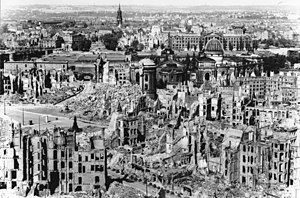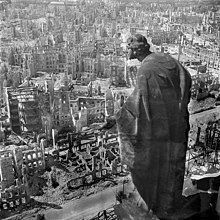
Back قصف درسدن (الحرب العالمية الثانية) Arabic Drezden bombardmanı Azerbaijani درسدن بومباردیمانی AZB Бамбаваньне Дрэздэну BE-X-OLD Бомбардировки на Дрезден Bulgarian Bombardeig de Dresden Catalan Bombardování Drážďan Czech Дрездена бомбӑлани CV Luftbombardementet af Dresden Danish Luftangriffe auf Dresden German
You can help expand this article with text translated from the corresponding article in German. (June 2023) Click [show] for important translation instructions.
|
| Bombing of Dresden | |||||||
|---|---|---|---|---|---|---|---|
| Part of strategic bombing during World War II | |||||||
 Dresden after the bombing | |||||||
| |||||||
| Belligerents | |||||||
|
|
| ||||||
| Strength | |||||||
|
| ||||||
| Casualties and losses | |||||||
| 7 aircraft (1 B-17 and 6 Lancasters, with crews) | Up to 25,000 people killed[1][2] | ||||||

The bombing of Dresden was a joint British and American aerial bombing attack on the city of Dresden, the capital of the German state of Saxony, during World War II. In four raids between 13 and 15 February 1945, 772 heavy bombers of the Royal Air Force (RAF) and 527 of the United States Army Air Forces (USAAF) dropped more than 3,900 tons of high-explosive bombs and incendiary devices on the city.[3] The bombing and the resulting firestorm destroyed more than 1,600 acres (6.5 km2) of the city centre.[4] Up to 25,000 people were killed.[1][2][a] Three more USAAF air raids followed, two occurring on 2 March aimed at the city's railway marshalling yard and one smaller raid on 17 April aimed at industrial areas.
Postwar discussions about whether the attacks were justified made the event a moral cause célèbre of the war.[6] Nazi Germany's desperate struggle to maintain resistance in the closing months of the war is widely understood today, but Allied intelligence assessments at the time painted a different picture. There was uncertainty over whether the Soviets could sustain its advance on Germany, and rumours of the establishment of a Nazi redoubt in Southern Germany were taken too seriously.[7]
The Allies saw the Dresden operation as the justified bombing of a strategic target, which United States Air Force reports, declassified decades later, noted as a major rail transport and communication centre, housing 110 factories and 50,000 workers supporting the German war effort.[8][9] Several researchers later asserted that not all communications infrastructure was targeted, and neither were the extensive industrial areas located outside the city centre.[10] Critics of the bombing argue that Dresden was a cultural landmark with little strategic significance, and that the attacks were indiscriminate area bombing and were not proportionate to military gains.[11][12][13] Some claim that the raid was a war crime.[14] Nazi propaganda exaggerated the death toll of the bombing and its status as mass murder, and many in the German far-right have referred to it as "Dresden's Holocaust of bombs".[15][16]
In the decades since the war, large variations in the claimed death toll have led to controversy, though the numbers themselves are no longer a major point of contention among historians.[17] City authorities at the time estimated that there were as many as 25,000 victims, a figure that subsequent investigations supported, including a 2010 study commissioned by the city council.[2][18] In March 1945, the German government ordered its press to publish a falsified casualty figure of 200,000, and death tolls as high as 500,000 have been claimed.[19][20][21] These inflated figures were disseminated in the West for decades, notably by David Irving, a Holocaust denier, who in 1966 announced that the documentation he had worked from had been forged and that the real figures supported the 25,000 number.[22]
- ^ a b "Dresden Historical Commission" (PDF). Abschlussbericht der Historikerkommission zu den Luftanfriffen auf Dresden zwischen dem 13 un 15 Februar 1945. Retrieved 13 July 2023.
- ^ a b c "Dresden historical commission publishes final report". www.dresden.de. 19 January 2024.
- ^ *The number of bombers and tonnage of bombs are taken from a USAF document written in 1953 and classified secret until 1978 (Angell 1953).
- Taylor (2005), front flap,[verification needed] which gives the figures 1,100 heavy bombers and 4,500 tons.
- Webster and Frankland (1961) give 805 Bomber Command aircraft 13 February 1945 and 1,646 US bombers 16 January – 17 April 1945.(Webster & Frankland 1961, pp. 198, 108–109).
- ^ Harris 1945.
- ^ Evans, Richard J. (2008). The Third Reich at War, 1939–1945 (Kindle ed.). London: Allen Lane. para. 13049.
- ^ Selden 2004, p. 30: Cites Schaffer 1985, pp. 20–30, 108–109. Note: The casualty figures are now considered lower than those from the firebombing of some other Axis cities; see Tokyo 9–10 March 1945, approximately 100,000 dead, and Operation Gomorrah campaign against Hamburg July 1943, approximately 50,000 dead (Grayling 2006, p. 20)
- ^ Overy 2013, p. 391.
- ^ Cite error: The named reference
USAFHDwas invoked but never defined (see the help page). - ^ Tustin, Chief Historian Joseph P. (11 December 1954). "Why Dresden was bombed – a review of the reasons and reactions" (PDF). United States Air Force in Europe. Office of Information Service Headquarters. Archived from the original (PDF) on 14 February 2022.
- ^ McKee 1983, p. 62.
- ^ Dresden was a civilian town with no military significance. Why did we burn its people? Archived 21 April 2016 at the Wayback Machine By Dominic Selwood. The Telegraph, 13 February 2015
- ^ Addison & Crang 2006, Chapter 9 p. 194.
- ^ McKee 1983, pp. 61–94.
- ^ Furlong, Ray (22 June 2004). "Dresden ruins finally restored". BBC News.
- ^ Cite error: The named reference
Volkerywas invoked but never defined (see the help page). - ^ Rowley, Tom (8 February 2015). "Dresden: The wounds have healed but the scars still show". The Telegraph. Archived from the original on 3 October 2017.
- ^ Overy 2013, pp. 334, 482.
- ^ Neutzner 2010, p. 68.
- ^ Bergander 1998, p. 217.
- ^ Taylor 2004, p. 370.
- ^ Atkinson 2013, p. 535.
- ^ "Wie David Irving eingestand, eine Fälschung genutzt zu haben". Dresdener Neueste Nachrichten (in German). 24 January 2005.
Cite error: There are <ref group=lower-alpha> tags or {{efn}} templates on this page, but the references will not show without a {{reflist|group=lower-alpha}} template or {{notelist}} template (see the help page).